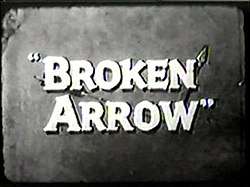Broken Arrow (TV series)
| Broken Arrow | |
|---|---|
 Title card | |
| Genre | Western |
| Directed by |
Richard L. Bare William Beaudine John English Charles F. Haas Joseph Kane Bernard L. Kowalski Frank McDonald Hollingsworth Morse Ralph Murphy Albert S. Rogell |
| Starring | Narrated by: John Lupton (season one), Bob LeMond (season two) |
| Composer(s) |
Alec Compinsky Stanley Wilson Paul Sawtell |
| Country of origin | United States |
| Original language(s) | English |
| No. of seasons | 2 |
| No. of episodes | 73 |
| Production | |
| Executive producer(s) | Irving Asher |
| Producer(s) |
Alan Armer Mel Epstein |
| Cinematography |
Frank Redman Karl Struss Charles Van Enger |
| Running time | 30 mins. |
| Release | |
| Original network | ABC |
| Original release | September 25, 1956 – September 23, 1958 |
Broken Arrow is a Western series which ran on ABC-TV in prime time from 1956 through 1958 on Tuesdays at 9 p.m. Eastern time. Repeat episodes were shown by ABC on Sunday afternoon during the 1959–60 season. Selected repeats were then shown once again in prime time (on Sunday evenings) during the summer of 1960.
Synopsis
Broken Arrow is a fictionalized account of the historical relationship between Indian agent Tom Jeffords, played by John Lupton, and the Chiricahua Apache chief Cochise, portrayed by Michael Ansara.
The series was based on the novel Blood Brother by Elliott Arnold, which was made into the movie Broken Arrow in 1950. The television pilot aired on May 1, 1956, on CBS's The 20th Century-Fox Hour, with Lupton in the title role. The series, which began on September 25, 1956, was produced by TCF Television Productions, the TV division of 20th Century-Fox and was filmed at 20th Century-Fox Studios. The series was syndicated under the title Cochise.
Broken Arrow was one of the few westerns to portray Native Americans in a positive light, but Michael Ansara found the role unchallenging. Ansara told TV Guide magazine in a 1960 interview: "Cochise could do one of two things–stand with his arms folded, looking noble; or stand with arms at his sides, looking noble."[1]
Tom Fadden (1895–1980) played the character Duffield in seventy episodes of the series. Early in his career, Sam Peckinpah was among the writers on the series.
In the second season opener, "White Man's Magic" (October 1, 1957), Peter Hansen appears as Captain Farrell, whose fiancée, Peggy, portrayed by Nan Leslie, is kidnapped in a stagecoach attack by Apache renegades led by Geronimo, portrayed in this segment by Ric Roman and later in film by Chuck Connors. Jeffords and Cochise succeed in freeing Peggy by making Geronimo think he is facing death from a bullet that has actually been successfully extracted from his body.[2]
Guest stars
- Chris Alcaide appeared twice, as Brown Eagle in "Passage Deferred" (1956) and as John Brett in "Hired Killer" (1958).
- Merry Anders, as Amy Breece in "Smoke Signal" (December 10, 1957)
- Phyllis Avery played an unnamed schoolteacher in the episode "The Teacher" (November 19, 1957).
- Trevor Bardette was cast twice, as Whittier in "The Captive" (1956) and Don Mateo in "Conquistador" (1957).
- Frank Cady, as Thaddeus Parker in "Devil's Eye (November 12, 1957)
- John Doucette appeared in "The Broken Wire" (May 14, 1957).
- Robert Knapp, as Lieutenant Neal in the episode, "Son of Cochise" (1957)
- Nan Leslie as Peggy in "White Man's Magic" (October 1, 1957)
- Mort Mills guest starred as Halley in "Black Moment" (October 29, 1957).
- Leonard Nimoy, in "Conquistador" (October 8, 1957)
- Gregg Palmer, as Lieutenant Savage in "White Savage" (December 24, 1957)
- James Philbrook, as Clem Harrison in "Manhunt" (1958)
- Gilman Rankin, of the western series Tombstone Territory, as Tawanga in "The Doctor"
- Paul Richards, as Bret Younger in "The Desperado" (March 26, 1957)
- Robert F. Simon, as Ben Slade in the pilot episode and as General Everitt in the episode "Ghost Face"
- Ray Teal, as Fenster in "The Bounty Hunters" (November 26, 1957)[2]
Cultural references
- The Blackfoot Indians used a broken arrow to signal that they would cease fighting.
References
- ↑ Alex McNeil, Total Television, New York: Penguin Books, 1996, 4th ed., p. 121
- 1 2 "Broken Arrow: 'White Man's Magic'". Internet Movie Database. Retrieved August 29, 2012.
Sources
- Brooks, Tim and Marsh, Earle, The Complete Directory to Prime Time Network and Cable TV Shows
External links
- Broken Arrow on IMDb
- Broken Arrow at TV.com